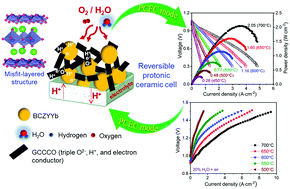Transition from perovskite to misfit-layered structure materials: a highly oxygen deficient and stable oxygen electrode catalyst†
Abstract
Despite the recent substantial progress in reversible protonic ceramic cells (RPCCs) it remains essential to further develop oxygen electrode materials that show superior activity and stability for oxygen reduction and evolution reactions due to the intrinsically sluggish kinetics of oxygen electrode reactions at lower temperature (<700 °C). We report a novel misfit-layered compound Gd0.3Ca2.7Co3.82Cu0.18O9−δ (GCCCO) as a superior and durable bifunctional oxygen electrode material for RPCCs. The maximum power densities achieved with GCCCO cells are notably high, reaching 1.16 and 2.05 W cm−2 at 600 and 700 °C, respectively, in the fuel cell mode, surpassing previously reported results. Moreover, in the electrolysis mode, the GCCCO cells reached current densities of −1.53 and −9.35 A cm−2 at 500 and 700 °C, respectively, at an applied voltage of 1.5 V. The superior catalytic performances of GCCCO are correlated to the oxygen defect rich structure, triple (O2−/H+/e−)-conducting property, needle-like grain morphology, and suitable thermal expansion coefficient.

- This article is part of the themed collection: Energy Frontiers: Electrochemistry and Electrochemical Engineering


 Please wait while we load your content...
Please wait while we load your content...